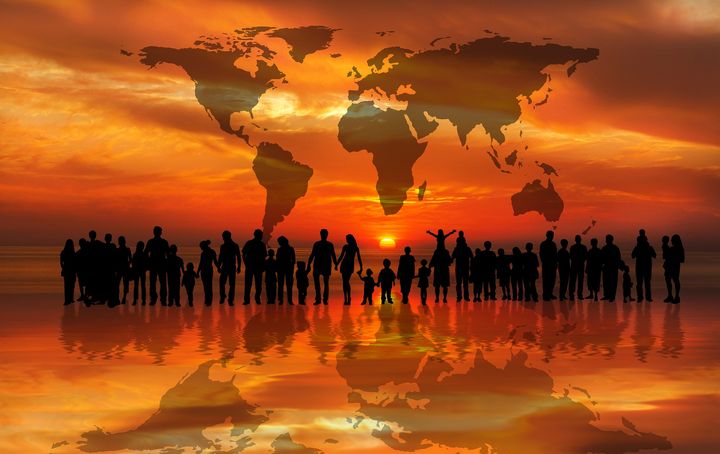What will be the population of the Earth by 2020, if in the near future an obvious shortage of useful resources can be observed on its individual continents? According to experts, the potential of the planet is not unlimited, although at the moment we are only talking about stocks of water and food. But already in the next few years, as the depletion of mineral deposits is depleted, the pace of industrial development may also decline. And this will inevitably lead to stagnation and stagnation, and, according to the UN forecast, all this will happen against the background of a constant increase in the population of the Earth.
Growth dynamics
Based on the percentage ratio, the average annual population growth is about 1.11%. This is an order of magnitude lower than in 1963, when the peak of growth was recorded, which was due to a number of factors. Then the increase was 2.19%, but after that the pace began to slow down to its current value.
The population of the planet will grow and this process cannot be influenced through artificial restrictions and prohibitions, which scientists say. The only positive thing is a gradual decrease in the growth rate, given that in 2020 it will be 1%, and in 2050 only 0.5%. Thus, it is easy to calculate how many people will be on Earth by 2020 - no more than 7,758,156,792 people. At the same time, the boundary of 8 billion will be overcome in 2025, and in 15 years more than 9 billion people will live on the planet.

Leaders and outsiders
As recent demographic studies have shown, in developed countries there will not be an increase in population, and in some regions this indicator will be negative or equal to zero. Moreover, the increase in the number of inhabitants of individual states will be determined not by a high birth rate, but by a constant influx of migrants. According to the forecast, the most difficult demographic situation will be observed in Japan and Italy, where the phenomenon of aging populations is clearly visible. The United States, Australia and Israel will be in a better position: these countries will have the highest growth rate, although if in 2010 they lived 32.3% of all the inhabitants of the planet, then by 2020 they will account for only 17% .
It is possible that in the middle of the century the growth rate of the number of inhabitants of developed countries may become negative. But this will be a short-term phenomenon and gradually the situation will level out.
The undisputed leader in terms of the number of inhabitants will be China, and India will get the honorable second place in 2020. It is assumed that in total more than 1.4 billion people will live in these two states, but gradually this indicator will grow, even when in Europe there will be a clear decline in the birth rate.
A high growth rate in the near future will show Brazil and Indonesia. In 2020, they will be second only to the United States in terms of population. Thus, the top five will be 4 countries with developing economies, while the 49 poorest countries will also demonstrate demographic growth, resulting in a population of 2.5 billion. According to scientists, this is a rather alarming signal, given that it is almost 2 times more than the population in developed countries.And subsequently, this trend will only intensify: if in 2013 they accounted for 12.5%, then by 2020 up to 17% of the world's inhabitants will live in poor countries.

Demographic situation by continent
If we talk about the number of people on individual continents of the Earth, then we can note that:
- Record-holders by the number of inhabitants will be the countries of Asia. Already in 2020, more than half of the world's population will live here, and this is about 5 billion people.
- Despite the lack of resources, acute shortages of water and food, Africa will be in second place. On this continent, a traditionally high birth rate will be observed, due to which about 20 billion people will live here by 2040. Such dynamics will continue until the end of this century.
- Central and South America will take an honorable third place, as the population of these regions also continues to grow. But by the end of the century, they will have exhausted their capabilities, reaching a maximum in the number of inhabitants of 800 million people.
- The fourth place will be taken by Europe, where there is a clear decline in the birth rate. It is noteworthy that back in the 90s of the last century, this continent occupied an honorable second place (in 1996, it was replaced by Africa). Perhaps this is due to the fact that at present about 700 million people live in European countries. And, according to scientists, this is the ultimate value for this region. At the same time, an aging population is observed, which is due to a higher standard of living.
- In 2020, more than 330 million people will live in North America, making this region the fifth largest population. But by the end of the century, we will be talking about 450 million people.

According to experts, such a heterogeneous situation across regions is associated with a difference in the birth rate: if in developed countries there are 2.1 children per woman of childbearing age, then in some poor countries this indicator can be almost 2.5 times higher. At the same time, developing Latin American and Asian countries, as well as the poorest countries in Africa, are expected to show the highest population growth rates.
Read also:




















